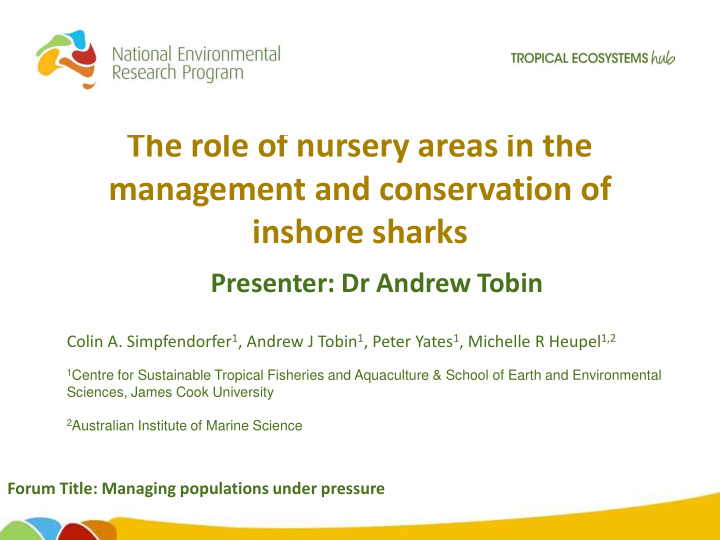



The role of nursery areas in the management and conservation of inshore sharks Presenter: Dr Andrew Tobin Colin A. Simpfendorfer 1 , Andrew J Tobin 1 , Peter Yates 1 , Michelle R Heupel 1,2 1 Centre for Sustainable Tropical Fisheries and Aquaculture & School of Earth and Environmental Sciences, James Cook University 2 Australian Institute of Marine Science Forum Title: Managing populations under pressure
SHARKS UNDER PRESSURE • Growing global recognition of threats to sharks and serious declines in some species. • IUCN Red List indicates globally 17% of 1045 species are Threatened and 46% are Data Deficient. • Global conservation via CITES (16 spp, including 10 from GBR) and Convention on Migratory Species (7 spp). • BUT, sharks are also fishery resources that can be fished sustainably if well managed.
GREAT BARRIER REEF SHARKS • GBR is home to 133 species of sharks and rays (>10% global diversity). • Threats to GBR sharks • Fishing • Habitat loss/modification • Climate change • Pollution • Fishing threats are mostly to inshore sharks, with the gillnet fishery taking at least 38 species. • Fishery take of sharks is managed by QDAFF (TAC, size limits, species limits, GBRMPA zoning, etc) to reduce risk.
SHARK NURSERY AREAS • Nearshore tropical waters often act as important nurseries for sharks. • Multiple nursery areas can increase resilience of shark populations (Yates et al. 2012) through portfolio effects. • The aim of this study was to determine the spatial and temporal variation in shark nursery area use along the GBR coast. Yates, P.M., Heupel, M.R., Tobin, A.J., and Simpfendorfer, C.A. (2012). Diversity in young shark habitats provides the potential for portfolio effects. Marine Ecology-Progress Series 458, 269-281.
PROJECT 6.2 NURSERY AREA SURVEYS • Gillnet and longline surveys Rockingham Bay • Five bays • Quarterly sampling • Sharks • Identified Bowling Green Bay • Measured • Sexed Townsville Upstart Bay • Maturity state determined • Tagged Edgecumbe Bay • Released Bowen N • Data analysed to look for Repulse Bay differences in shark 100 km communities between bays and over time
RESULTS I • 1178 sharks from 19 species. • 16 species occurred as juveniles. • At least 7 of these species meet the criteria for nursery area use. • Majority of sharks caught were mature (mostly Aust. sharpnose)
RESULTS II Mature • Little size difference between mature and Immature immature sharks. • Aust. sharpnose sharks are the same size as juveniles of other species and may derive similar benefits from occurring in “nursery areas”. Comparison of length-profiles between immature and mature sharks. Cumulative length profiles for immature (grey circles) and mature (black circles) sharks. Data are pooled into 100 mm bins.
RESULTS III • Significant differences in juvenile shark communities between bays. • All bays shared some species (e.g. blacktip, spottail). • Edgecumbe and Upstart bays had lowest numbers of juvenile sharks and lowest diversity. • Rockingham and Repulse bays had the highest catches and greatest diversity. Catch composition of immature sharks. Four bay pairs had significantly different communities (blue lines; ANOSIM). The most distinguishing species are indicated (SIMPER).
CONCLUSIONS • Nearshore shark communities are more diverse than those in reef habitats. • Nearshore waters along the GBR coast are important nursery areas for sharks. • While many adult sharks also occur in nearshore areas, most are similar size to juveniles. • Shark communities vary between bays along the GBR coast.
APPLICATION OF WORK • Maintaining healthy nearshore habitats will be important for resilient coastal shark populations. • Results will assist in ongoing management of coastal shark species and the inshore gillnet fishery. • Results and data will be used in the assessment of the status of key fished shark species on the Qld east coast. • Improved scientific understanding of the spatial and temporal variation in nursery area use.
FUTURE DIRECTIONS • Surveys are continuing. • Exploring factors that may drive differences in species composition between bays. • Examining environmental drivers of shark movements. • Estimating fishing mortality rates of key species caught in fisheries to determine sustainable take levels (A Tobin FRDC project)
Management agencies STAKEHOLDERS Fisheries Fisheries Qld Advocacy groups (local, national Biodiversity and habitat Resource and GBR users international) GBRMPA ( fishers, sharks divers, etc.) SEWPAC International treaties (CITES, CMS, Research and monitoring QNPRSR etc.) agencies QDAFF, universities, AIMS, CSIRO Use Regulations Data Values and advice Knowledge
THANK YOU Ste ve Mo o re , a nd vo lunte e rs fo r fie ld sa mpling e ffo rts
Recommend
More recommend